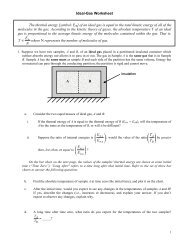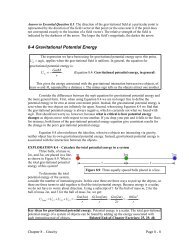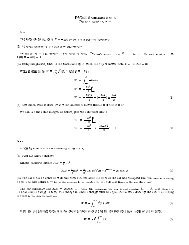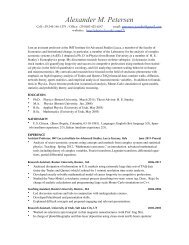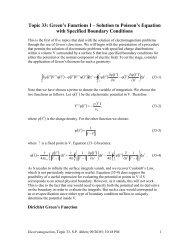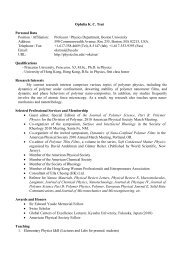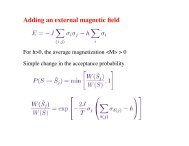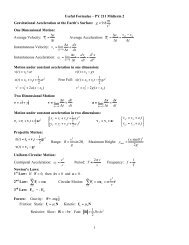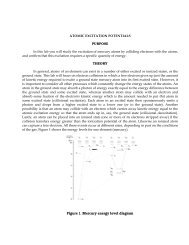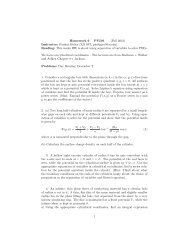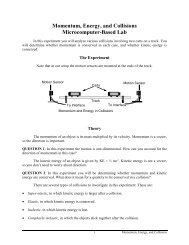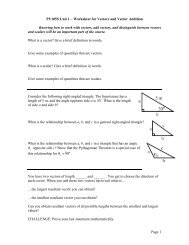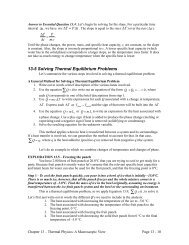Answers to selected problems from Essential Physics, Chapter 16
Answers to selected problems from Essential Physics, Chapter 16
Answers to selected problems from Essential Physics, Chapter 16
- No tags were found...
Create successful ePaper yourself
Turn your PDF publications into a flip-book with our unique Google optimized e-Paper software.
(e)7mg sinθ= ma + FS= ma55gsinθ5(9.8 m/s )(0.3 m)a = = = 1.05 m/s7 7 (2.0 m)22(f)2.0 m = 1 2 at 2t =4.0 ma= 1.95 sπ π17. (a) m (b) m (c) No. First, we have <strong>to</strong> add the displacements as vec<strong>to</strong>rs, and2 2the displacements are in different directions. Second, the displacement associated withthe rotational motion has a smaller magnitude than the distance associated with therotational motion, because the direction of motion changes as the wheel rotates. (d) Theπdisplacement has components of 1.0 m vertically and m horizontally. Using the2Pythagorean theorem with these components gives 1.9 m for the magnitude of thedisplacement.19. 22.5 m/s21. The speeds are the same in the two cases. Because the sphere rolls without slipping,mechanical energy is conserved, so the gravitational potential energy is transformed in<strong>to</strong>rotational kinetic energy and translational kinetic energy. The gravitational potentialenergy is the same in the two cases, and the fraction of the <strong>to</strong>tal kinetic energy that istranslational kinetic energy is the same in both cases, so the speed must be the same.23. (a) A’s kinetic energy is larger by a fac<strong>to</strong>r of two. (b) A’s angular speed is larger bya fac<strong>to</strong>r of two. (c) They have the same angular momentum.25. (a) the s<strong>to</strong>pping time would double (b) the s<strong>to</strong>pping time would double(c) the s<strong>to</strong>pping time would be half as long27. We actually don’t have enough information <strong>to</strong> solve this problem. Let’s take thewheel’s mass <strong>to</strong> be 800 grams and its radius <strong>to</strong> be 40 cm, with all the wheel’s massconcentrated around the rim of the wheel.(d) The net <strong>to</strong>rque is simply the frictional <strong>to</strong>rque,F2(f) τF t mr ( ωf ωi)2τ (e) Δ L= IΔ ω= mr ( ωf− ωi)Δ= − (g) τ F= 0.026 N m, in the direction opposite <strong>to</strong> the wheel’sdirection of rotation.<strong>Essential</strong> <strong>Physics</strong>, <strong>Answers</strong> <strong>to</strong> <strong>selected</strong> <strong>Chapter</strong> 11 Problems Page 3
29. (a) At any instant in time, the speed of block A is equal <strong>to</strong> the speed of block B,because they are connected by the same fixed-length string. (b) 34.5 kg31. The assumption here is that the ball rolls without slipping. In that case, h = 2.7 R.This is a little larger than the result of 2.5 R we got previously for a frictionless block.The extra height in this case gives us a little more gravitational potential energy <strong>to</strong> startwith, which goes in<strong>to</strong> the ball’s rotational kinetic energy at the <strong>to</strong>p of the loop.33. 39 m/s35. (a) Ui + Ki + Wnc = U f + K f, and define the zero level for gravitational potentialenergy <strong>to</strong> be the lowest point (the final point).(b) K i = 0, because the disk starts <strong>from</strong> rest; U f = 0 , because the disk ends up at thezero level for gravitational potential energy; W nc = 0, because no non-conservative forcesact on the disk (there is a friction force acting, but because it is static friction the energyassociated with friction is the rotational kinetic energy of the disk).4(c) Ui = K f(d) v= gh = 2.6 m/s31 2 1 2mgh = mv + Iω2 21 2 1⎛12⎞v= mv + ⎜ mr ⎟2 2⎝2⎠r3 2= mv42237. Let’s assume that the sphere rotates only, and that there is no translational motion.U + K + W = U + K , and define the zero level for gravitational potential(a)i i nc f fenergy <strong>to</strong> be the level of the sphere’s center of mass.(b) K i = 0, because the sphere starts <strong>from</strong> rest; U i = 0 and U f = 0 , because thesphere’s center of mass does not move, and the center of mass starts and ends at the zerolevel for gravitational potential energy.5Fd(c) Wnc = K f(d) ω = = 18 rad/s2mr1 2 1 2 2Fd = Iω= mr ω2 539. (a) 5.0 rad/s 2 , clockwise (b) 2.5 rad/s 2 , clockwise(c) 20 rad/s 2 , clockwise (d) 10 rad/s 2 , clockwise<strong>Essential</strong> <strong>Physics</strong>, <strong>Answers</strong> <strong>to</strong> <strong>selected</strong> <strong>Chapter</strong> 11 Problems Page 4
41. The tension only needs <strong>to</strong> be different when the system accelerates. In that case, thepulley has an angular acceleration, which requires a net <strong>to</strong>rque. The only way <strong>to</strong> have anet <strong>to</strong>rque acting on the pulley is for the two tensions <strong>to</strong> be different. (a) With everythingat rest, the two tensions are the same. (b) In this case, the system accelerates. Inparticular, the pulley’s angular acceleration is directed counterclockwise, so the tensionabove the block of mass M is larger than the tension in the part of the string that is abovethe block of mass m. (c) In this case, there is no acceleration, so the tension is the same atall points in the string.43. (a) a = g/5. If we use g = 9.8 m/s 2 , we get a = 1.96 m/s 2 . (b) The speed of eitherblock at this time is 3.92 m/s. To get the angular velocity, we need <strong>to</strong> know the radius ofthe pulley. If r = 10 cm, then the angular velocity is 39 rad/s, directed counterclockwise.45. (a) 4.1 m/s 2 , down (b) 1.6 m/s 2 , up47. 1.1 m/s 2 , down49. (a) 2.0 m/s 2 (b) The tension is larger between block B and the pulley. In thissituation, the pulley has an angular acceleration directed clockwise, so there must be a net<strong>to</strong>rque acting clockwise on the pulley. The net <strong>to</strong>rque is proportional <strong>to</strong> the differencebetween the two tensions, with the clockwise <strong>to</strong>rque <strong>from</strong> the tension in the vertical par<strong>to</strong>f the string being larger than the counterclockwise <strong>to</strong>rque <strong>from</strong> the tension in thehorizontal part of the string. This is true only if the tension in the vertical part of thestring is larger than the tension in the horizontal part of the string.(c) 24 N in the vertical part of the string, and 21 N in the horizontal part51. Yes, the spool can remain motionless in this case, if there is an appropriate force ofstatic friction acting down the slope. Then, the force you exert on the spool up the slopewould balance the sum of the force of static friction and the component of the force ofgravity that acts down the slope. The <strong>to</strong>rque you exert about the center of the spool wouldbalance the <strong>to</strong>rque the force of static friction exerts about the center of the spool.53. (a)982 33MR (b)19 Mg55. The bicycle wheel will spin for twice as long as the solid disk, because the rotationalinertia of the wheel is two times larger than the rotational inertia of the disk.57. (a) The pennies farther <strong>from</strong> the axis are more likely <strong>to</strong> lose contact with the meterstick than are the pennies close <strong>to</strong> the axis. All points on the meter stick will have thesame angular acceleration, but the linear acceleration of any point is the angularacceleration multiplied by the distance <strong>from</strong> the axis <strong>to</strong> the point. Thus, points farther<strong>from</strong> the axis will have the greatest linear acceleration and, if the linear accelerationexceeds g, the pennies won’t keep up with the meter stick. (b) The acceleration at the far3end of the stick is a= g, while at the center it is only half of this, 324 g .<strong>Essential</strong> <strong>Physics</strong>, <strong>Answers</strong> <strong>to</strong> <strong>selected</strong> <strong>Chapter</strong> 11 Problems Page 5
59. (a) The system’s angular momentum stays the same – there is no net external <strong>to</strong>rquebeing applied <strong>to</strong> the system. When you get farther <strong>from</strong> the center, the system’s rotationalinertia increases - the angular speed decreases so the angular momentum stays the same.(b) The system’s rotational kinetic energy decreases. The merry-go-round applies aninward directed force <strong>to</strong> you, so when you move out <strong>from</strong> the center negative work isdone by the turntable on you. This accounts for the loss of mechanical energy.(c) When you get <strong>to</strong> the outer edge and you are rotating with the turntable, the system’sangular velocity is 1.8 rad/s directed clockwise. To conserve this angular velocity withthe merry-go-round at rest, you would have <strong>to</strong> run with an angular velocity of 3.6 rad/s,directed clockwise.61. (a) 3.7 m/s (b) 3.8 s (c) 3.8 revolutions63. (a) Angular momentum is conserved. (b) Translational kinetic energy is notconserved. (c) Gravitational potential energy is not conserved. (d) Total mechanicalenergy is conserved. The <strong>to</strong>tal mechanical energy (the sum of the kinetic energy and thepotential energy) is conserved, but the gravitational potential energy increases with thecomet’s distance <strong>from</strong> the Sun. Thus, the translational kinetic energy must decrease <strong>to</strong>compensate for the increase in potential energy as the comet moves farther <strong>from</strong> the Sun.On its return journey <strong>to</strong>ward the Sun, the kinetic energy increases as the potential energydecreases.<strong>Essential</strong> <strong>Physics</strong>, <strong>Answers</strong> <strong>to</strong> <strong>selected</strong> <strong>Chapter</strong> 11 Problems Page 6


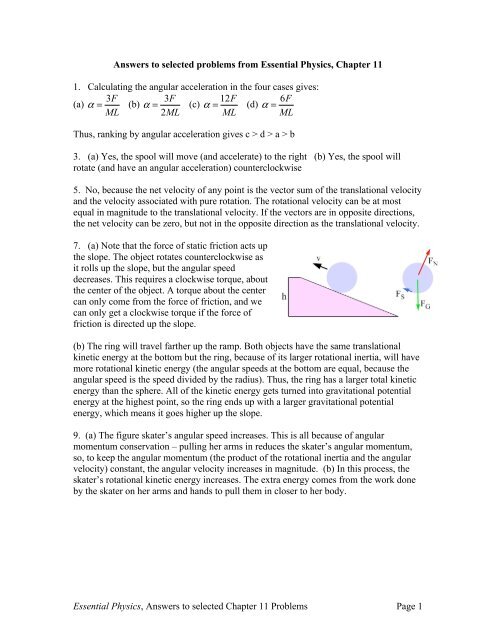
![arXiv:1303.7274v2 [physics.soc-ph] 27 Aug 2013 - Boston University ...](https://img.yumpu.com/51679664/1/190x245/arxiv13037274v2-physicssoc-ph-27-aug-2013-boston-university-.jpg?quality=85)
